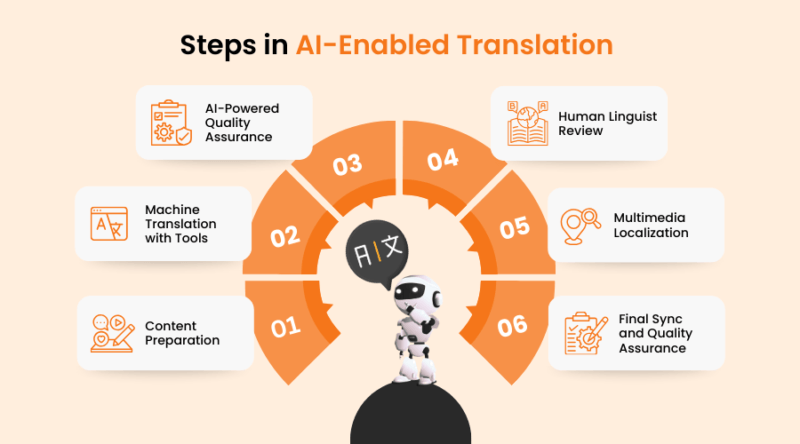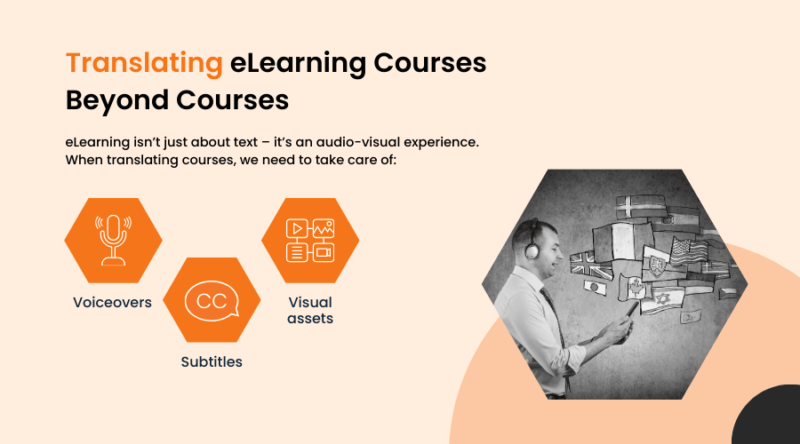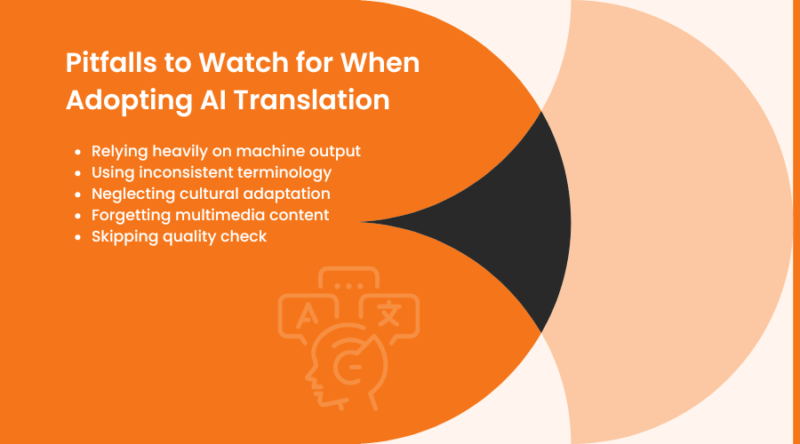Why Multilingual Learning Can’t Be An Afterthought
Delivering corporate training in just one language is no longer enough. A diverse workforce demands inclusive, accessible learning experiences, and that starts with language. But anyone who’s ever managed eLearning translations knows it’s no walk in the park. Traditional methods are slow, expensive, and hard to scale. Worse, they often delay training rollouts and eat into L&D budgets.
With AI-enabled translation tools, it’s now possible to localize eLearning courses faster, with higher consistency and significantly lower costs. But Artificial Intelligence alone isn’t the silver bullet. The real transformation happens when AI works together with human expertise—leveraging automation for speed, and linguistic nuance for impact. By combining the power of AI platforms such as Smartcat with the rigor of human review, we can scale training across geographies without compromising quality.
Let’s unpack how AI is reshaping the eLearning translation process: what works, what to watch for, and how to make it work for your team.
From Manual eLearning Translation To AI-Enabled Localization
For years, eLearning translation meant long timelines, high costs, and coordination headaches. You’d start with extracting content, send it to translators, bring it back, format it manually, and hope it all syncs properly in your authoring tool. Multiply that by five or ten languages, and it’s easy to see why many L&D teams either delayed localization or skipped it altogether.
Now, instead of relying on fully manual workflows, modern localization begins with powerful machine translation platforms such as Smartcat. These platforms can instantly translate large volumes of content, applying natural language processing to retain tone, structure, and intent. What once took weeks now happens in hours.
But here’s the catch: AI isn’t replacing humans, it’s enhancing them. The best results come from a human-in-the-loop model, where linguists, Subject Matter Experts (SMEs), and Instructional Designers work alongside AI to ensure the output is accurate, relevant, and instructionally sound. By doing so, you can reduce turnaround time by up to 50%, save nearly 40% on translation budgets, and scale your training across multiple regions without the usual bottlenecks.
How AI-Enabled Translation Actually Works
To many L&D professionals, “AI translation” might sound like a black box—type in English, get Spanish. But the reality is more structured and much more collaborative. Here’s a simplified view of how AI-enabled eLearning translation works, particularly in a rapid eLearning context.

Image by CommLab India
Step 1: Content Preparation
It starts with identifying what needs to be translated from a custom eLearning course: scripts, on-screen text, assessments, video narration, and UI elements. Text is extracted from eLearning authoring tools such as Articulate Storyline or Rise and prepared in a translation-friendly format (typically XLIFF, Word, or CSV).
Step 2: Machine Translation Via Smartcat
This is where the heavy lifting begins. Platforms such as Smartcat use neural machine translation (NMT) engines to produce first-pass translations. These engines are trained on large datasets and can learn from corrections over time, improving accuracy with every project.
Step 3: AI-Powered Quality Assurance
Smartcat and similar platforms include automated QA tools that flag basic issues, such as missing punctuation, inconsistent terminology, or broken tags.
Step 4: Human Linguist Review
Professional linguists review the machine-translated content, correcting tone, cultural missteps, and technical terminology. This step is crucial for training content, where even small errors can lead to confusion or compliance risks.
Step 5: Multimedia Localization
Voiceovers are recorded using AI-generated voices or traditional narration, depending on context and budget. On-screen graphics with embedded text are localized, and subtitles are synced using speech-to-text tools and human oversight.
Step 6: Final Sync And QA
Translated content is reintegrated into the authoring tool, synced with visuals, and tested for flow, formatting, and learner experience. Everything from button labels to quiz logic is reviewed before final deployment.
This AI-plus-human workflow delivers speed without sacrificing quality—an ideal match for the fast-paced, multilingual training needs of global organizations.
Rapid eLearning And AI Translation: A Match Made For Speed
Speed has always been the promise of rapid eLearning. Tools such as Articulate Storyline, Rise, and iSpring allow L&D teams to quickly develop engaging, SCORM-compliant custom eLearning courses without months of production time. But when it comes to multilingual delivery, speed often hits a wall—unless AI translation is part of the equation.
The modular structure of rapid eLearning makes it inherently well-suited to AI-enabled translation. Content is typically organized in short screens, microlearning blocks, and templates, all of which lend themselves to streamlined localization. When paired with AI platforms such as Smartcat, the translation process becomes even more efficient.
Here’s how:
- Text extraction is clean and structured, making it easier to feed into AI translation tools.
- Smartcat’s translation memory ensures consistency across screens and modules, even as content is updated.
- Translations can be quickly reimported into tools such as Rise or Storyline with minimal reformatting.
- Multimedia elements (narration and subtitles) can be localized in parallel using AI voiceover tools and captioning engines.
This synergy cuts down on turnaround time, reduces human errors, and lets L&D teams roll out multilingual eLearning courses simultaneously, not in staggered waves.
Beyond Text: AI In Audio, Video, And Visual Localization
eLearning isn’t just about text—it’s an audio-visual experience. Voiceovers, subtitles, images with embedded text, and screen recordings are often integral to learner engagement. And when you’re localizing content, ignoring these components can break the experience for non-English speakers.

Image by CommLab India
AI Voiceovers
AI-generated voices have come a long way from the robotic tones of the past. With natural-sounding text-to-speech (TTS) engines, it’s now possible to generate professional-grade voice-overs in dozens of languages without the cost and time of traditional studio recordings. These voices can be customized by tone, pace, gender, and even regional accents.
Automated Subtitling
Speech-to-text algorithms can automatically generate subtitles for video content, synced precisely with narration. These captions can then be translated using AI and reviewed by humans to ensure clarity, especially for complex technical training.
Visual Asset Localization
Diagrams, screenshots, and infographics often contain text baked into images. AI-assisted tools can detect and extract this text, translate it, and reintegrate it into the visual layout. This ensures learners in different regions see the same content, just in their own language.
The Human-In-The-Loop Model: Accuracy Without The Cost Explosion
AI alone doesn’t guarantee accuracy. Especially when dealing with technical, compliance-heavy, or nuanced content, raw machine translation can miss the mark. Terminology may be off. Context can get lost. A simple mistranslation can change the meaning of a policy or procedure—something no L&D leader wants on their hands.
That’s where the human-in-the-loop model makes all the difference. In our approach, machine translation is the starting point, not the finish line. AI tools like Smartcat provide a fast and consistent first draft, using pre-trained models and translation memories to process content in minutes. But then comes the human refinement, the critical step where trained linguists, Subject Matter Experts, and Instructional Designers collaborate to ensure quality.
Here’s how the model works:
- Linguists review AI output for grammar, tone, and cultural sensitivity.
- SMEs validate technical accuracy and domain-specific terminology.
- Instructional Designers ensure learning intent and clarity are preserved across languages.
This layered review balances speed with precision. It avoids the inefficiencies of translating from scratch while eliminating the risks of relying entirely on AI.
Pitfalls To Watch For When Adopting AI Translation
While AI-enabled eLearning translation can be a game-changer, it’s not foolproof. Many organizations make the mistake of jumping in without a clear strategy, leading to subpar results, rework, and in some cases, reputational risk.

Image by CommLab India
Here are some common pitfalls to avoid:
- Overreliance on raw machine output. AI translation is fast, but it’s not always context-aware. Without human oversight, tone and intent can get lost, especially in regulatory or soft skills training.
- Inconsistent terminology. Without centralized glossaries or translation memory, terms may vary across modules or courses, confusing learners.
- Neglecting cultural adaptation. Literal translations can sound awkward or inappropriate if cultural norms aren’t considered. Local idioms, humor, and visuals often need adjustment.
- Forgetting multimedia content. Text is just one part of the learning experience. Ignoring voiceovers, subtitles, and on-screen visuals leaves courses only partially localized.
- Skipping final QA. Even with the best tools and people, errors slip through. A final review within the authoring tool is nonnegotiable to catch layout issues, cut-off text, or broken interactions.
When To Use AI-Powered Translation And When Not To
AI-enabled translation works best for high-volume, process-driven training. Think compliance modules, product training, system rollouts, and customer service scenarios. These are typically structured, repeatable, and benefit greatly from speed and consistency.
However, for emotionally charged, culturally sensitive, or high-stakes leadership programs, a fully human-led translation may still be the safer choice. Content that hinges on tone, storytelling, or subtle persuasion often requires deeper human insight.
The key is knowing when to lean on AI and when to lean in with human expertise. At CommLab India, we help clients strike that balance for every learning need.
The Future Of Translation In L&D: Smart, Scalable, And Inclusive
The next frontier of L&D isn’t just digital; it’s multilingual by default. As organizations expand into new markets and embrace remote workforces, localized learning will no longer be optional. The future lies in scalable, tech-enabled solutions that make inclusivity effortless.
AI is evolving fast. Tomorrow’s tools will go beyond text, offering real-time translation, personalized language preferences, even AI-generated avatars delivering training in a learner’s native tongue. Voice cloning, adaptive content, and feedback-driven language models are already emerging.
But the winning formula won’t be tech alone. It will be the thoughtful integration of AI with Instructional Design and human expertise, ensuring training is not only accurate but effective and culturally resonant. Because the real goal isn’t just multilingual content. It’s multilingual learning that works.
Ready For Multilingual Learning At The Speed Of Business?
Training a global workforce means more than translating words. It means delivering learning that resonates, regardless of geography or language. AI-enabled translation, when paired with human insight, gives L&D teams the power to do just that—faster, better, and more cost-effectively than ever before.
Whether you’re scaling compliance training, launching product education, or supporting multilingual onboarding, the right approach can transform translation from a bottleneck into a strategic enabler.
At CommLab India, we believe the future of learning is smart, scalable, and inclusive. And it speaks every learner’s language.

